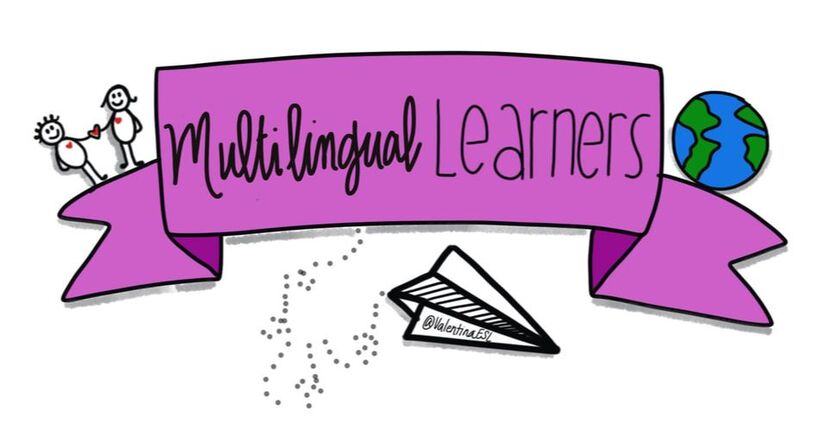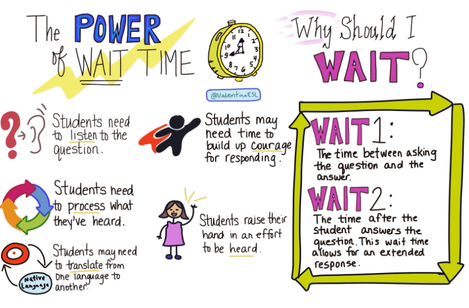|
The Power of 3 Seconds How can something so simple have such an incredible impact? Wait time...it can make or break a lesson. It's the difference between a student fully being engaged and participating and a student becoming frustrated and checking out. Why wait? When students are learning a new language, they benefit from time to listen to the question and process what they've heard. Many students need additional time to take the words they heard and translate them in order to comprehend the message. Once they understand the question. They need time to formulate a response in English and build the courage to use their voice. Not all ELLs find this an easy task. For me personally as an ELL, this was the most difficult part of the equation and exactly where I got stuck. I couldn't find the courage with in the given wait time. So if a student has built up enough courage they will raise their hand and hopefully be called on to respond.
TIP: To lower the affective filter of ELLs and help them build courage to respond, embrace a growth mindset about language learning. Even if the response is not grammatically correct, it's the risk and the learning that are important. Never publicly correct an ELL's grammar. The best way to help students who make a grammatical error is to recast. For example if a student says, "The water evaporate because of heat." You can simply respond by saying something like, "Yes, the water evaporated because of the heat." If we don't give enough wait time for all of this to happen, we shut our ELLs down before they move past translating what we've said. At this point some will get frustrated. Others will tune us out. Many will start to think that the questions are not for them, so why should they listen. Wait time is a clear message to all of our students that the learning is for them. They are important and we will not give up on them. Waiting an extra 3-5 seconds after asking a question seems like a small thing to do but it has large outcomes. Research by Mary Budd Rowe says that when we implement this extra wait time student responses increase. Rowe defined wait time as the time between when the teacher asks a question and the student responds. This is also called Wait Time 1. She found that traditionally wait time was less that 1.5 seconds. However, by doubling wait time to 3 seconds, several positive effects were experienced:
Wait Time 2 is the time after the student responds and the teacher replies. Waiting an additional few seconds here can elicit an extended response from the student. In some cases, the teacher may nod or give a non verbal signal of thinking to allow the student an opportunity to continue responding. The student may not be able to add any additional information, but Wait Time 2 is just that opportunity for extra output and elaboration. Scenario 1: Teacher: Samantha, why did the water evaporate? Samantha: Because of the heat. The rest of the class: (Tuned out) They are all thinking...Why should we waste our energy on thinking about an answer or focusing on what the teacher is saying right now? She's talking to Samantha any way, not us. Check out. Scenario 2 with wait time: Teacher: Why did the water evaporate? (insert wait time here) When you can finish this sentence, stand up. "The water evaporated because..." (insert wait time here) Share with your elbow partners and then take your seat. Students: (Think, stand, share, sit) Teacher: Samantha, why did the water evaporate? Samantha: The water evaporated because of the heat. Teacher: (nods and looks up as if thinking-Wait Time 2) Samantha: Heat from the hot plate evaporated the water just like the sun's heat evaporates water outside when there's a puddle. In the new version, the teacher implemented wait time 1 and wait time 2. During wait time 1, all students had an opportunity to think about the answer to the question. Everyone was involved in the questioning and answering. By offering a sentence stem, students can more readily respond to the content in the question. The stem is not required, rather it is there to help students who need an extra push to get their thought going. Asking students to stand when they are ready to share, gives everyone time to formulate a response. This way no one is caught off guard. I remember a teacher I had who loved to ask the student who was off task to answer a question. It seemed like that was her goal-to embarrass the kid who wasn't paying attention. We know now that that type of questioning does not support learning. It doesn't make students want to learn or make them feel safe. Instead of just calling on one student to respond, allowing everyone to share with a partner gets 100% participation. All kids are talking and listening. I love this part also because if a student didn't have a great answer, then at least they heard from a partner and maybe learned something more from them. This partner share prepares students in case they are called on to share with the whole group too. In Scenario 2, Samantha had already shared with a partner, so she was warmed up and had a idea from her partner if she needed it. Since the teacher nodded and didn't cut Samantha off right after her initial response, she was given a second Wait Time. This allowed her to extend her response. Wait Time 2 leaves the door open for students to continue their thoughts. Small change-Big rewards! For additional information on Wait Time here are a couple resources: Using Think Time Wait Time: What's In It For Me?
Tan Huynh
10/21/2017 06:35:41 am
Hi, Valentina.
Valentina
10/21/2017 09:46:58 am
Tan, of course you can. That would be a great honor. And you know I'm all about sharing for the greater good of our ELs.
Teaching children is fairly easy. Teaching grown-up people is a different matter entirely. Anyway, there are some brilliant ideas in this article. After all, everyone needs a bit of time to come up with some coherent and reasonable answer to a question. Comments are closed.
|
Categories
All
|


 RSS Feed
RSS Feed
